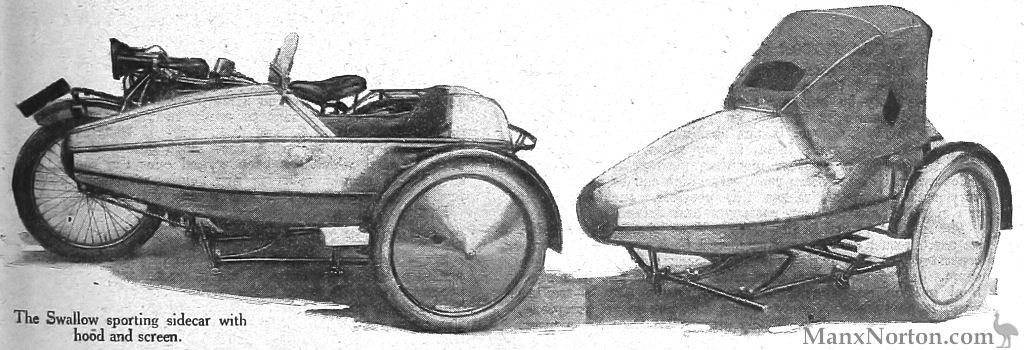


NEW SPORTING SIDECARS.
Aluminium Zeppelin-shaped Bodies for Lightweights or Heavyweights..
OWNERS of sporting sidecar outfits have long been regarded as a somewhat selfish class, thinking more of the light weight of their sidecars than the comfort of their passengers. But it has frequently been pointed out in these columns that a sidecar body in keeping with the "sporting" character of the machine and its driver need not necessarily be uncomfortable.
Sidecar manufacturers are beginning to realise this, and at least two comparatively little-known sidecars will in 1923 be all that is required by the passengers.
The first of these is the Swallow, which is produced in Blackpool by the Swallow Sidecar Co., Bloomfield Road, and will be at the Olympia Show. From the illustration it will be seen that, while retaining the favoured Zeppelin outlines, the Swallow has the roominess and equipment of the popular touring types.
Constructed of polished aluminium, it permits the seating accommodation to be in the form of a cock-pit, having a high back rest which supports the passenger's shoulders, while a coupé hood is provided for the occasions when the driver be-best [sic] of it. This coupé hood is detachable, and is supported on a single stick which normally lies horizontally behind the bulbous back. The chassis is sufficiently strong for use with the largest machines or the popular 500 c.c. types, and the equipment includes a cover-all apron, lamp, polished aluminium disc and step.
The Motor Cycle, November 9th, 1922.
Graceful Sports Model.
Swallow Sidecar Co., Bloomfield Road, Blackpool.
Amongst the most distinctive sidecars in the Show are the sporting Swallows in polished aluminium.
Although light and "racy" in appearance, the construction is strong and suitable for machines of any power. Many sporting bodies are fitted to chassis obviously unsuited for machines of larger capacity than 500 c.c, but in this instance the designers have rightly met the demand for strength from owners of powerful twins, as well as merely providing grace of outline with minimum wind resistance.
All the models are provided with a windscreen of the aeroplane type, consisting of a small semi-circular Triplex panel mounted in aluminium. Included in the equipment is a small quickly detachable hood, which may be erected in a very few seconds. It is carried in the locker at the rear.
Olympia Show 1922, The Motor Cycle November 30th 1922, page 869